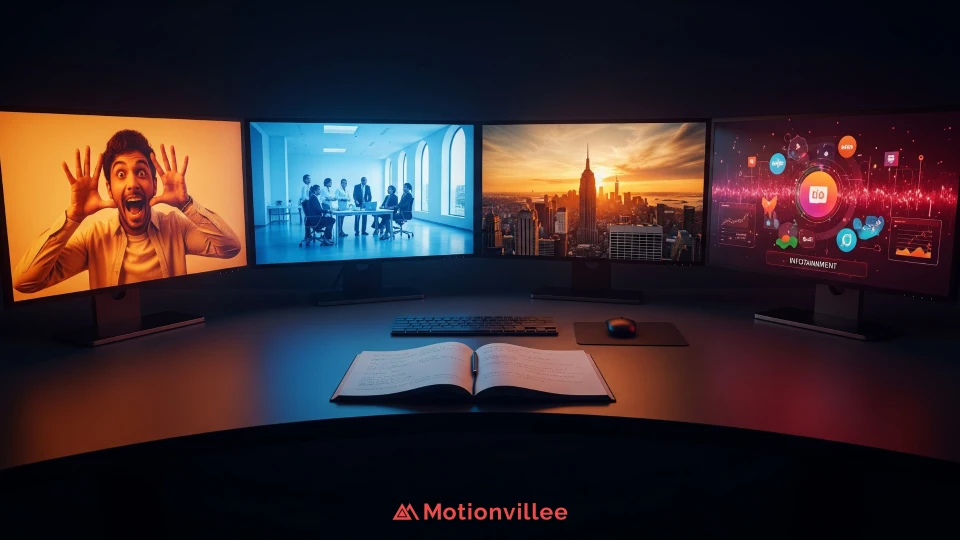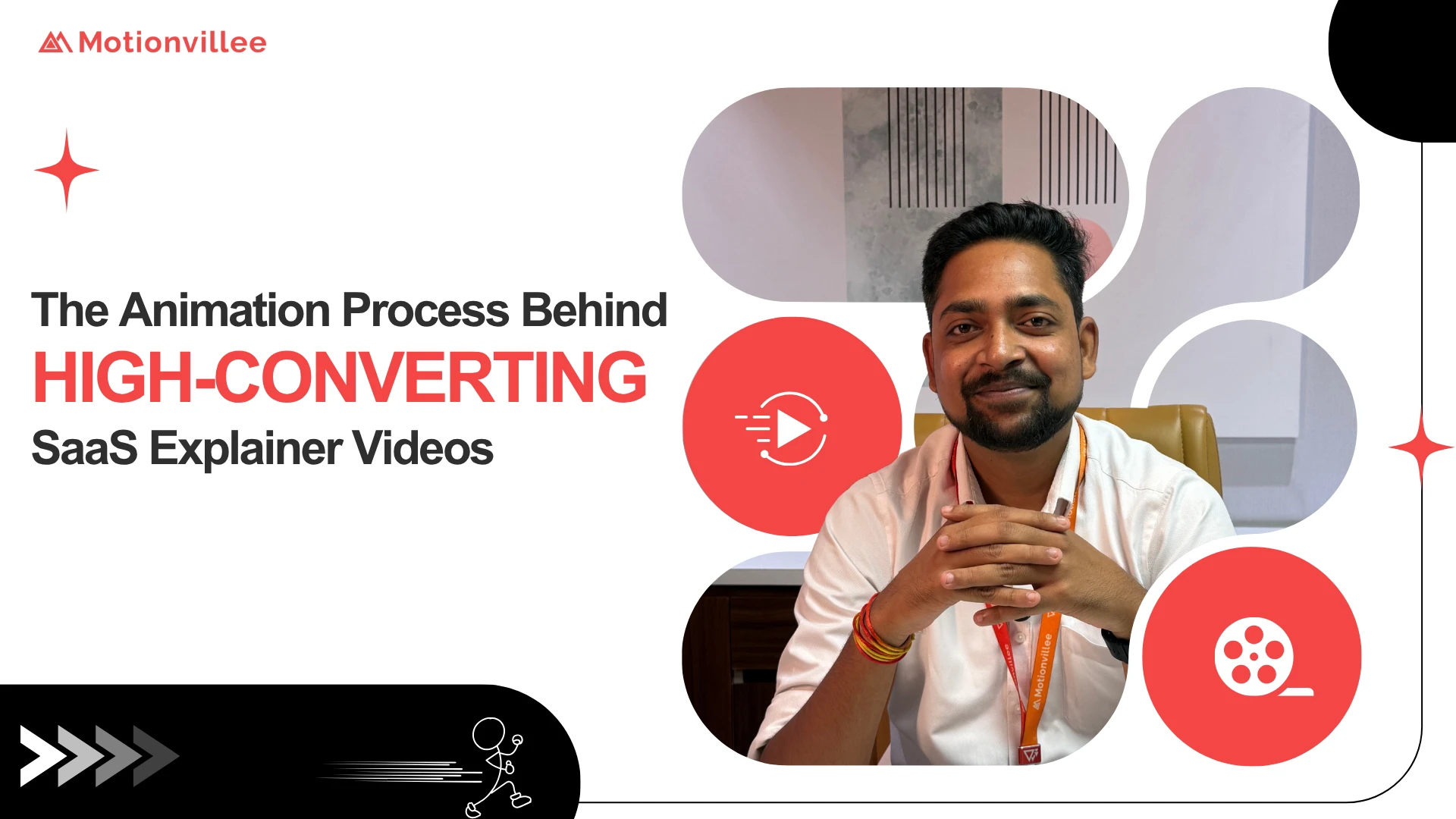Turning Ideas into Words that Work
Welcome to Stage 2 of Motionvillee’s 5-Stage Video Production Process, Scripting. A strong video scripting process transforms creative concepts into structured narratives that drive results.
If Stage 1 (Creative Direction) is where ideas are born, Stage 2 is where those ideas find their voice. It is the stage where thoughts turn into structure, emotion turns into words, and imagination becomes communication.
Behind every viral reel, indulge-worthy YouTube video, or memorable brand film lies one common element, a powerful script. It does not just make content sound polished; it gives it purpose. A strong script guides the story, sharpens delivery, and ensures that every second of video serves a clear message.
At Motionvillee, scripting bridges the gap between creativity and clarity. Our professional video scripting helps writers and directors align tone, pacing, and storytelling style with the brand’s voice. Working with an Explainer Video Production team ensures content feels authentic, flows naturally, and leaves a lasting impression.

What Makes a Script Engaging?
An engaging script feels like a conversation, not a performance. It does not lecture. It connects. The best scripts guide attention without forcing it, keeping the viewer curious from start to finish.
At Motionvillee, we focus on these key principles:
- Clarity: Every sentence serves the message.
- Emotion: The tone should reflect the brand’s personality.
- Flow: Transitions should feel invisible but intentional.
- Brevity: Every word must earn its place.
A great script does not try to impress the audience. It helps them understand. It is how you turn information into storytelling and strategy into emotion.

Short-Form vs Long-Form Scripting
Different formats demand different writing muscles. Effective script writing for videos adapts to content length and platform requirements.
Short-form videos
(like Reels or YouTube Shorts) rely on quick, impactful delivery. You only have a few seconds to grab attention and build interest.
- Start strong: The first three seconds are crucial.
- One idea per script: Simplicity drives retention.
- Punchy language: Short sentences and everyday words keep it natural.
- End clean: Close with a takeaway, insight, or clear next step.
Long-form content
(like explainers, tutorials, or podcasts) gives more room to build depth but also more chances to lose attention.
- The opening hook: Treat the first 30 seconds like a trailer.
- Structured flow: Break content into clear sections, introduction, key ideas, and wrap-up.
- Mini-hooks: Add new energy every few minutes to reset attention.
- Smooth transitions: Help viewers follow along effortlessly.
- Closing loop: Revisit the opening promise at the end to make it memorable.
The art lies in maintaining clarity no matter how long the script runs.
Adapting to Different Content Styles
Not all scripts sound the same. Tone and rhythm change depending on the video’s purpose.
At Motionvillee, our scripting team adapts based on the brand and audience:
- Comedy or short skits: Focus on timing, rhythm, and payoff.
- Story-based content: Build a 3-act flow, setup, conflict, and resolution.
- Infotainment: Combine facts with humor and relatable examples.
- Corporate explainers: Keep it formal yet friendly, clear, and confident.
Every genre has its own tempo. The key is writing with intention, shaping language that fits both the message and the audience. Whether creating a SaaS Explainer Video or corporate training content, the video scripting process remains consistent.

Why Hooks Are Non-Negotiable
Without a hook, even a great video gets ignored. Hooks are what stop the scroll, make viewers curious, and build anticipation.
In short-form videos, hooks live in the first three seconds. In long-form videos, they reappear throughout to maintain attention. A good hook is not just about clickbait; it is about curiosity.
Examples of effective hooks include:
- “Most people get this wrong…”
- “Here’s what nobody talks about…”
- “But wait, here’s the twist…”
We use hooks strategically to drive retention and set the stage for the story that follows.
Why Writing Scripts Is Crucial
A strong script does more than guide dialogue. It gives the entire production a backbone. Engaging video scripts are the foundation of successful B2B Video Production.
Here is what well-written scripts achieve:
- Save time during production: The team knows exactly what to shoot.
- Improve delivery: Narration and voiceovers sound natural and confident.
- Increase retention: Viewers stay longer because the story flows.
- Enhance storytelling control: Nothing is left to chance; every moment has purpose.
In short, scripting turns creative chaos into organized storytelling.
Common Scripting Mistakes to Avoid
Even experienced creators make small mistakes that weaken their videos.
- Writing too much or too little.
- Skipping hooks or failing to build flow.
- Ignoring audience tone and perspective.
- Sounding too scripted or unnatural.
- Overexplaining instead of showing.
A good script should sound like it was written to be spoken, conversational, confident, and human.
Writing That Builds Connection
Scripting is where strategy meets storytelling. It gives structure to creativity and ensures that every second of your video communicates with intent.
At Motionvillee, scripting represents Stage 2 of our 5-Stage Video Production Process, the bridge between creative direction and design. It is where stories gain structure and ideas find their rhythm.
Once the script is ready, the rest of the process, from visuals to animation, moves with clarity and focus.
🎬 Looking to turn your ideas into impactful video stories? Let’s write your next chapter together. 👉 Start your project with Motionvillee







